Taking on a major DIY project or home improvement often means dealing with building regulations. Whether you handled them yourself or an architect managed the details, these regulations are essential for ensuring safe and compliant construction.
For those unfamiliar, UK building regulations are a set of rules approved by the Secretary of State to guide the construction industry. They cover essential dos and don’ts to ensure safety and quality in building projects.
The regulations primarily focus on health and safety, protecting occupants from hazards like electrical shocks, falls, or other risks. In recent years, energy conservation has also become a significant focus.
Approved Document D, based on the 1992 regulations with updates in 2002, 2010 and 2013 specifically addresses the use of toxic materials in construction, including those used for cavity insulation.

Approved Document D – Toxic Substances – Download Approved Document D here
Amendments Made to Approved Document D
To ensure that all Approved Documents remain relevant to today’s construction practices and reflect any new products, tools or innovations that come along they are subject to periodic change and to save publishing the original document every time this happens, updates or amendments are released instead.
The main amendments that have occurred recently are:
- 2013 Amendment: This change only applied to England and was concerned with materials and workmanship.
- 2010 Amendment: No notable content changes, just a re-numbering of regulations after they had been re-ordered.
What Does Approved Document D Deal With?
In essence, Approved Document D of the Building Regulations deals with potentially dangerous and toxic substances used during construction and ensures that they are delt with correctly during use and don’t pose a threat to any inhabitants after works have been completed.
The original Approved Document D was first published in 1992, however since its initial version, it has undergone several additions or amendments. These were in 2002, 2010 and 2013.
The latest document today is a consolidation of the original and the amendments up to this point.
In respect to how the document affects most building projects, this is usually around the cavity area.
When adding UF insulation to cavity walls in building projects, it’s essential to ensure safety. Toxic fumes from the insulation must be blocked from entering occupied areas of the building, as these fumes could pose health risks.
Proper sealing of cavities prevents harmful gases from affecting indoor spaces, ensuring a safe environment for occupants and this is the main focus of Document D.
What Types of Insulation Pose a Risk?
Among the various types of cavity wall insulation, the regulations specifically address Urea Formaldehyde (UF) Foam that is used to insulate many homes in the UK.
This type of insulation can release harmful fumes if not properly managed.
To ensure safety, it must be sealed with a continuous barrier to prevent fumes from entering the building and posing health risks to occupants.
Why Is Approved Document D Important?
The primary aim of Approved Document D is to safeguard the health and well-being of anyone using a building. Toxic materials can cause serious health issues if they are not handled properly.
The document sets clear requirements to minimise these risks, ensuring that both construction professionals and DIY enthusiasts follow safe practices.
It also contributes to improving building standards across the UK, creating a safer environment for everyone.
How to Work Safely With UF Insulation
Among the various types of cavity wall insulation, the regulations specifically address Urea Formaldehyde (UF) Foam:
- The Inside leaf of a given cavity wall must be constructed of bricks or blocks
- The wall and cavity must be inspected before to confirm that it is suitable for insulating inline with the guidelines stated in BS8208-1:1985
- Any contractor carrying out the work must hold a current and valid Certificate of Registration of Assessed Capability
- Any materials used must conform with BS5617:1985 and the specifications set out in these guidelines to ensure that it is suitable for use within a cavity wall
- The insulating materials are installed following the guidelines stated in BS5618:1985
Who Needs to Follow Approved Document D?
Builders, architects, and DIY enthusiasts working on projects that involve cavity wall insulation or other materials covered by the document must legally comply with any and all of its requirements.
Compliance is mandatory for both new builds and renovations, and local authorities often inspect projects to ensure these standards are met.
By following the guidelines in Approved Document D, you can avoid costly fines, protect your reputation, and ensure your project is safe and up to specifications now and for anyone in the future.
How to Ensure Compliance
To comply with Approved Document D, start by using certified, non-toxic materials and following proper installation techniques. Always consult the latest version of the document for updated rules and seek advice from a qualified professional if needed.
Regular inspections from your local Building Control officer and proper documentation throughout your project will also help demonstrate compliance and ensure peace of mind.
Among the various types of cavity wall insulation, the regulations specifically address Urea Formaldehyde (UF) Foam. This type of insulation can release harmful fumes if not properly managed.
So, to ensure safety for both yourself and anyone else that inhabits your home in the future, any UF insulation used must be sealed with a continuous barrier to prevent fumes from entering the building and posing health risks to occupants.

